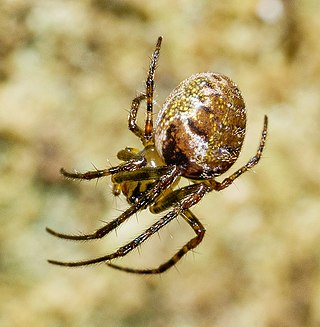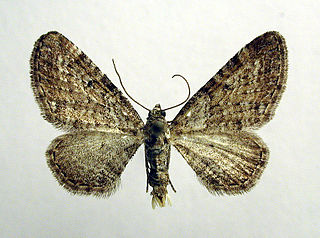
Eupithecia is the largest genus of moths of the family Geometridae, and the namesake and type genus of tribe Eupitheciini. Species in the genus are, like those of other genera in the tribe, commonly known as pugs. The genus is highly speciose, with over 1400 species, and members of the genus are present in most of the world with exception of Australasia. Roughly a quarter of described Eupithecia species occur in the Neotropical realm, where they have an especially high species diversity in the montane rain forests of the Andes. The genus includes a few agricultural pest species, such as the currant pug moth, Eupithecia assimilata, which is a pest on hops, and the cloaked pug moth, Eupithecia abietaria, which is a cone pest in spruce seed orchards.

The juniper pug or juniper looper is a moth of the family Geometridae. The species was first described by Michael Denis and Ignaz Schiffermüller in 1775. It is found throughout the Palearctic and in the Nearctic.
Pimoidae is a small family of araneomorph spiders first described by J. Wunderlich in 1986. As re-circumscribed in 2021, it is monophyletic, and contained 85 species in two genera. It is closely related to the Linyphiidae, and is sometimes treated as synonymous with that family.

Taraire is a small genus of Polynesian long-jawed orb-weavers. The genus was first described by A. Álvarez-Padilla, R. J. Kallal and Gustavo Hormiga in 2020, and it has only been found in New Zealand. They build vertical orb webs near forest floors, and can be found resting in the center. The genus name is a reference to Beilschmiedia tarairi, the native New Zealand tree that they are commonly found in.

Eupithecia satyrata, the satyr pug, is a species of moth of the family Geometridae. It was described by Jacob Hübner in 1813. It is found from Ireland, through northern and central Europe east to all of Russia and central Asia and western Siberia to Tibet. It is also present in North Africa and North America.

Eupithecia pernotata, or Guenée's pug, is a moth of the family Geometridae. The species was first described by Achille Guenée in 1857. It is known from the Alps, through Romania to southern Russia. It is also found in Finland.
Pimoa cthulhu is a species of the spider family Pimoidae. It is one of twenty-one described species in the genus Pimoa.

Eupithecia subbrunneata is a moth in the family Geometridae. It is found in China and Russia.
Eupithecia demetata is a moth in the family Geometridae. It is found in Turkmenistan.
Eupithecia duena is a moth in the family Geometridae. It is found in Ecuador and Peru.
Eupithecia interrubrescens is a moth in the family Geometridae. It is found in Tibet.
Eupithecia irambata is a moth in the family Geometridae. It is found in India (Sikkim).
Eupithecia junctifascia is a moth in the family Geometridae. It is found in Colombia and Costa Rica.
Eupithecia lacteolata is a moth in the family Geometridae. It is found in Russia and Turkey.
Eupithecia mediobrunnea is a moth in the family Geometridae. It is found in Mexico.
Eupithecia mejala is a moth in the family Geometridae. It is found in Ecuador, Bolivia and Peru.
Eupithecia subsequaria is a moth in the family Geometridae. It is found in Turkey.
Eupithecia virescens is a moth in the family Geometridae. It is found in Brazil.
Pinkfloydia is a genus of small Australian long-jawed orb-weavers, reaching a maximum lengths of about 4.5 millimetres (0.18 in). It was first described by D. Dimitrov & G. Hormiga in 2011, and contains two species, found in New South Wales and Western Australia: P. harveyi and P. rixi. They have a unique rounded, cone-shaped head structure with one pair of large eyes and three pairs of smaller eyes. The genus is named after British rock band Pink Floyd.

Orsonwelles is a genus of American dwarf spiders that was first described by G. Hormiga in 2002. They are all native to the Hawaiian Islands, each species occurring on a single island, often at high elevations. One species has not been collected since the 1890s, and is believed to be extinct. The name honors the actor and film-maker Orson Welles. Many of the species names commemorate elements from Welles' films, radio productions, or roles.






